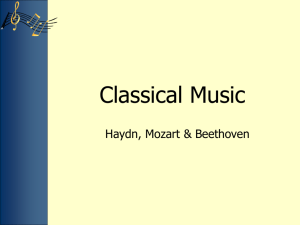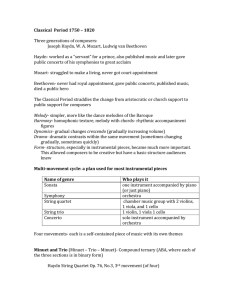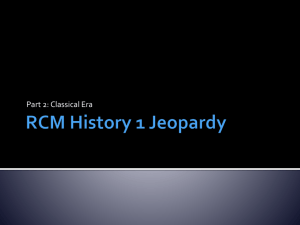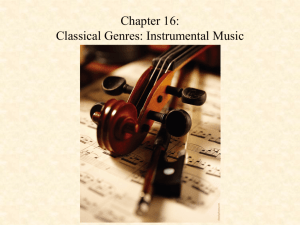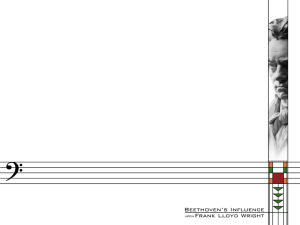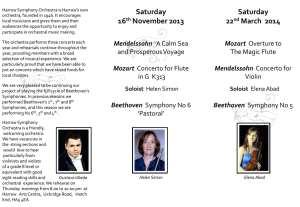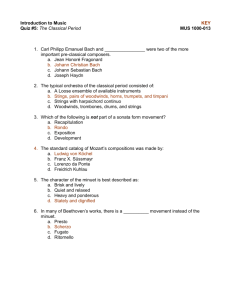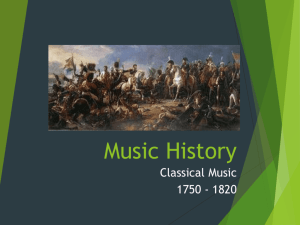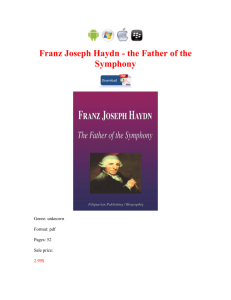Classical Period: Music, Art, Theatre & Dance Overview
advertisement
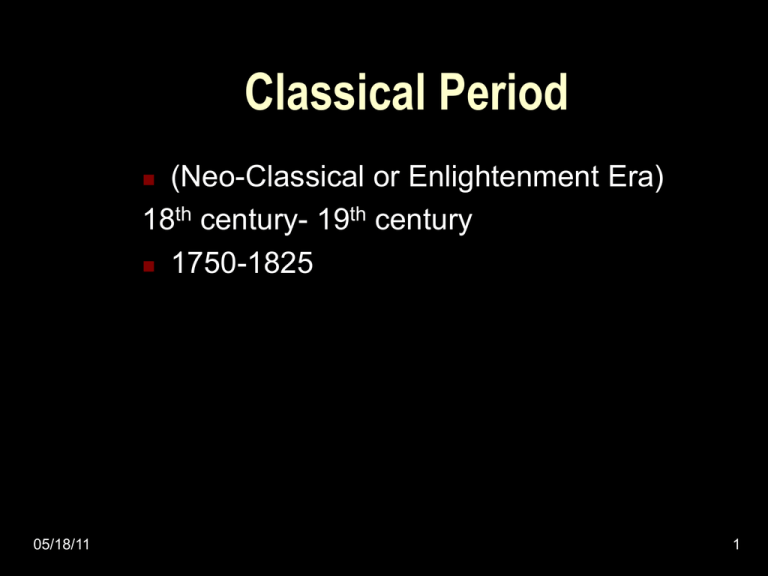
Classical Period (Neo-Classical or Enlightenment Era) 18th century- 19th century 1750-1825 05/18/11 1 Classical Style 05/18/11 “Neo” means new Also known as the age of reason Returned to ideas of ancient Greece & Rome Strict rules, pure uncomplicated Embraces the music of Haydn, Mozart, and Beethoven 2 Classical Music 05/18/11 2 important new kinds of music 1. Sonata-written in 3-4 movements (sections) for 1- 2 instruments 2. Symphony-large piece written in 3-4 movements for an orchestra 2 great composers of the time 1. Franz Joseph Haydn 2. Wolfgang Amadeus Mozart 3 Wolfgang Amadeus Mozart1756-1791 05/18/11 4 Wolfgang Amadeus Mozart Austrian born child prodigy (Unusual, extraordinary, a marvel having unusual skills at something at an early age) Was giving large scale performances by the age of 6 Known as 1 of the greatest composers of all time Composed 1st symphony at age 8 Composed very quickly He spread his reputation by publishing things, playing the piano and having one of his operas performed in 1782 Died a very poor man at the age of 35 Buried in Vienna, small ceremony & unmarked grave Composed The Magic Flute the year he died 05/18/11 5 Mozart’s Father; Leopold 05/18/11 6 Orchestra o o o o o 05/18/11 Orchestra-group of musicians Today’s orchestra established during this time Only had about 30-40 players, today 100+ Size of orchestra depended on size of the salon (small parlor) & wealth of the people attending Large concert halls didn’t exist. As they were built larger & larger, more instruments added to each instrument group Sections of first Orchestra o String Choir-violins, violas, cellos, & bass o 6 Woodwind players-2 flutes, 2 oboes, 2 bassoons o 4 Brass players-2 horns, 2 trumpets o Percussions section-1 pair kettle drums 7 Salon (Reading Hour) 05/18/11 8 Modern Orchestra 05/18/11 9 Franz Joseph Haydn1732-1809 05/18/11 10 Franz Joseph Haydn 05/18/11 Poor family, he was the son of a wheelwright. He trained as a choirboy at age 8 Later lived in a palace for 30 years & paid to write as much music as possible At age 60 was invited to go to London to compose symphonies & conduct public concerts Played the harpsichord (piano-like instrument) Grouped the instruments of the orchestra Known as the father of symphony, composed 100+ Nickname “Papa” Haydn He died in 1809 at the age if 77 11 Harpsichord 05/18/11 12 Harpsichord and Clavichord 05/18/11 13 Haydn’s Writing 05/18/11 14 Beethoven 05/18/11 15 Ludwig von Beethoven Born on December 16, 1770 in Bonn His first public concert was on March 26, 1778, at age 7 Became deaf in early 20s. Considered rude & temperamental by many Never heard his most famous symphony, 9th Symphony Died exactly 49 years later on the same day as his first concert. When he died it is said that 10,000 people attended his funeral. 05/18/11 16 Classical Dance The Romonov family in Russia wanted to westernize their court so they invited artists in western Europe to perform in Russia 05/18/11 17 Jean George Noverre 05/18/11 Was a choreographer who saw the need to reform in ballet. 18 Marius Petipa 05/18/11 Ballet dancer who danced at the Imperial Theatre & became chief ballet master Choreographed Don Quixote, La Bayadere, The Sleeping Beauty, the Nutcracker and Swan Lake. 19 Classical Theatre • Drama very important to aristocratic court • Melodrama means “music drama” • Time of French & American Revolution, philosophy & politics important • Called the “good old days” of literature 05/18/11 20 Moliere (Jean Baptiste Poquelin) French playwright & actor Worked for King Louis XIV Master of Satire (makes fun of humanity) His death caused superstition thru even modern theatre (He was wearing yellow when he died & is still supposedly bad luck to wear yellow) 05/18/11 21 Neo-Classical Art 05/18/11 Focused on the natural and belief n superiority of rational thought over emotion. Public buildings based on the ideals of perfection of humanity. 22 Jacques-Louis David Napoleon Crossing the St. Bernard Pass, c.1801 French artist Considered the hero of neoclassical art due to serious artworks that represents the ideals of that period. Official artist of French Revolution Painted leaders of the war & created costumes for them Death was a result of being ran over by a carriage 05/18/11 23 Thomas Jefferson 05/18/11 Thomas Jefferson was 3rd president, principal author of Declaration of Independence, architect, agriculturalist, etymologist, horticulturist, archaeologist, cryptographer, surveyor, paleontologist, lawyer, inventor, violinist, mathematician, author, & founder of U. of Virginia. Designed his home, Monticello, including automatic doors & the first swivel chair 24 Monticello & Jefferson Memorial 05/18/11 25 Neo-Classical Art Giovanni Paolo Pannini The Colosseum and the Arch of Constantine 05/18/11 26 Neo-Classical Architecture Rebelled against ornate Baroque style 05/18/11 27 Classic Greek Architecture 600 B.C. Temple of Hephaestus Parthenon at Acropolis 05/18/11 28 The Death of Marat 05/18/11 29
